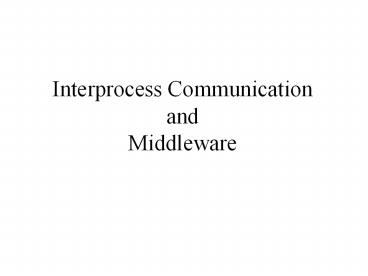Interprocess Communication and Middleware - PowerPoint PPT Presentation
1 / 28
Title:
Interprocess Communication and Middleware
Description:
Interprocess Communication. and. Middleware. Sockets and Ports. Source: G. Coulouris ... The operating system includes common network protocols (TCP/IP, ... – PowerPoint PPT presentation
Number of Views:49
Avg rating:3.0/5.0
Title: Interprocess Communication and Middleware
1
Interprocess CommunicationandMiddleware
2
Sockets and Ports
Node 2
Node 1
Source G. Coulouris et al., Distributed Systems
Concepts and Design
3
Crossing Hosts/Platforms
Source G. Coulouris et al., Distributed Systems
Concepts and Design
4
Provisions of Middleware
- Higher-level abstractions (RPC, RMI, )
- Location transparency
- Independent of communication protocols
- Independent of hardware/operating systems
- Use of several programming languages
5
The Middleware layer
The operating system includes common network
protocols (TCP/IP, ).
Source G. Coulouris et al., Distributed Systems
Concepts and Design
6
Request-Reply Communication
Source G. Coulouris et al., Distributed Systems
Concepts and Design
7
Request-Reply Communication Using HTTP
HTTP request message
HTTP reply message
Source G. Coulouris et al., Distributed Systems
Concepts and Design
8
Serialization (Marshalling)
Source G. Coulouris et al., Distributed Systems
Concepts and Design
9
Distributed Objects
- The object-based programming model is extended
- to allow objects in different processes to
interact - with one another.
- Client/Server
- Object References
- Interfaces
- Remote Method Invocation
- Exceptions
10
A CORBA IDL Example
Source G. Coulouris et al., Distributed Systems
Concepts and Design
11
Local and Remote Method Invocations
Source G. Coulouris et al., Distributed Systems
Concepts and Design
12
A Remote Object and Its Interface
Source G. Coulouris et al., Distributed Systems
Concepts and Design
13
Client Proxy (Stub) and Server Skeleton (Stub)
Source G. Coulouris et al., Distributed Systems
Concepts and Design
14
The RMI Software
- Proxy the local representative of the remote
object. - Dispatcher relays a request to the appropriate
skeleton method. - Skeleton unmarshals the request and invokes the
corresponding method in the remote object.
15
RPC/RMI Semantics
Source G. Coulouris et al., Distributed Systems
Concepts and Design
16
Java Remote Interfaces
Source G. Coulouris et al., Distributed Systems
Concepts and Design
17
A Java Server
Source G. Coulouris et al., Distributed Systems
Concepts and Design
18
A Java Server (contd)
Source G. Coulouris et al., Distributed Systems
Concepts and Design
19
A Java Client
Source G. Coulouris et al., Distributed Systems
Concepts and Design
20
CORBA
- Defined by OMG to hide the intricacies of network
programming. - An ORB (Object Request Broker) receives
invocations from a client and deliver them to a
target object. - The main communication protocol is GIOP (General
Inter-ORB Protocol), known as IIOP when
implemented over the Internet.
21
The CORBA Architecture
Source G. Coulouris et al., Distributed Systems
Concepts and Design
22
CORBA Object Interfaces
- Each object has an interface defined in IDL.
- An interface defines the operations that can be
called by the clients. - An interface can be implemented in one language
and called from by another. - The CORBA IDL includes features such as
inheritance of interfaces, exceptions, and
compound data types.
23
CORBA Programming with Java
- Define the interfaces using IDL and compile them
into Java interfaces. - Implement the interfaces with Java classes.
- Write a server main function that creates
instances of these classes and then inform the
underlying CORBA implementation. - Register the server.
- Write a client main function to connect to the
server and to use servers objects.
24
CORBA IDL Interfaces Shape and ShapeList
Source G. Coulouris et al., Distributed Systems
Concepts and Design
25
Java Interface Generated from the CORBA Interface
ShapeList
Source G. Coulouris et al., Distributed Systems
Concepts and Design
26
Java Implementation of Shapelist
Source G. Coulouris et al., Distributed Systems
Concepts and Design
27
Java Implementation of ShapeList (contd)
Source G. Coulouris et al., Distributed Systems
Concepts and Design
28
Java Implementation of a ShapeList Client
Source G. Coulouris et al., Distributed Systems
Concepts and Design































